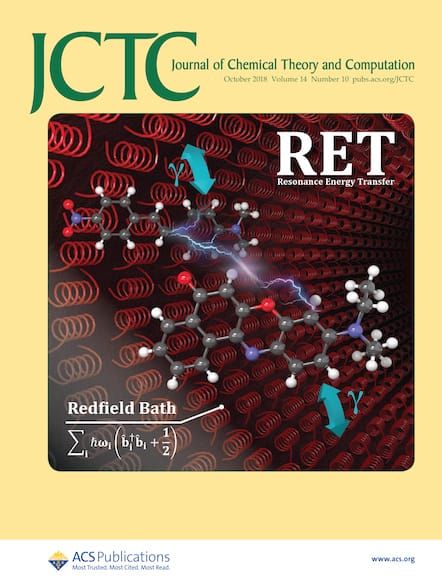Hydrophobicity-Governed Protein Adsorption on Poly(ω-methoxyalkyl acrylate) Surfaces: A Coarse-Grained Molecular Dynamics Study.
IF 5.5
1区 化学
Q2 CHEMISTRY, PHYSICAL
引用次数: 0
Abstract
Polymeric materials are widely used in medical devices, where their interactions with proteins play a critical role in determining biocompatibility. To better understand and predict these interactions, we extend the coarse-grained force field (FF), SPICA, to simulate protein adsorption on poly(ω-methoxyalkyl acrylate) (PMCxA) and poly(n-butyl acrylate) (PBA) surfaces. Notably, poly(2-methoxyethyl acrylate) (PMEA), a member of PMCxA family, is approved by the U.S. Food and Drug Administration for clinical applications. Our polymer FF was parametrized using the physical properties─density, interfacial tension, and hydration free energy─of small-molecule analogs representing the monomer units. Protein-polymer interactions were further calibrated using adsorption free energies of amino acid side-chain analogs on polymer-based monolayers. The developed SPICA-FF accurately reproduces both bulk polymer properties and protein adsorption behaviors in agreement with experimental and atomistic simulation data. Our simulations show that PBA strongly attracts water-soluble globular proteins, while PMEA resists adsorption when proteins retain their native structures. For PMCxA variants, protein adsorption correlates linearly with both surface water contact angle and the free energy of cavity formation at the interface, highlighting surface hydrophobicity─particularly the number of methylene units in the polymer side chains─as a key determinant. This work offers a validated framework for studying protein-polymer interactions at a coarse-grained level, enabling more efficient screening and design of polymer surfaces for medical applications. It highlights the significance of polymer surface chemistry in determining protein behavior, offering valuable insights for the rational design of biocompatible materials.疏水性控制的蛋白质在聚(ω-甲氧基丙烯酸酯)表面的吸附:粗粒度分子动力学研究。
高分子材料广泛应用于医疗器械,其与蛋白质的相互作用在决定生物相容性方面起着关键作用。为了更好地理解和预测这些相互作用,我们扩展了粗粒度力场(FF), SPICA,来模拟蛋白质在聚丙烯酸ω-甲氧基烷基酯(PMCxA)和聚丙烯酸正丁酯(PBA)表面的吸附。值得注意的是,聚(2-甲氧基乙基丙烯酸酯)(PMEA)是PMCxA家族的成员,已被美国食品和药物管理局批准用于临床应用。我们的聚合物FF是用代表单体单元的小分子类似物的物理性质──密度、界面张力和水化自由能──来参数化的。利用氨基酸侧链类似物在聚合物基单层上的吸附自由能进一步校准蛋白质-聚合物相互作用。开发的SPICA-FF准确地再现了体聚合物的性质和蛋白质吸附行为,与实验和原子模拟数据一致。我们的模拟表明,PBA强烈吸引水溶性球形蛋白,而PMEA在蛋白质保留其天然结构时抵抗吸附。对于PMCxA变体,蛋白质吸附与表面水接触角和界面上形成空腔的自由能呈线性相关,突出了表面疏水性──特别是聚合物侧链上亚甲基单位的数量──是一个关键的决定因素。这项工作为在粗粒度水平上研究蛋白质-聚合物相互作用提供了一个有效的框架,使医学应用中更有效地筛选和设计聚合物表面。它强调了聚合物表面化学在决定蛋白质行为中的重要性,为合理设计生物相容性材料提供了有价值的见解。
本文章由计算机程序翻译,如有差异,请以英文原文为准。
求助全文
约1分钟内获得全文
求助全文
来源期刊

Journal of Chemical Theory and Computation
化学-物理:原子、分子和化学物理
CiteScore
9.90
自引率
16.40%
发文量
568
审稿时长
1 months
期刊介绍:
The Journal of Chemical Theory and Computation invites new and original contributions with the understanding that, if accepted, they will not be published elsewhere. Papers reporting new theories, methodology, and/or important applications in quantum electronic structure, molecular dynamics, and statistical mechanics are appropriate for submission to this Journal. Specific topics include advances in or applications of ab initio quantum mechanics, density functional theory, design and properties of new materials, surface science, Monte Carlo simulations, solvation models, QM/MM calculations, biomolecular structure prediction, and molecular dynamics in the broadest sense including gas-phase dynamics, ab initio dynamics, biomolecular dynamics, and protein folding. The Journal does not consider papers that are straightforward applications of known methods including DFT and molecular dynamics. The Journal favors submissions that include advances in theory or methodology with applications to compelling problems.
 求助内容:
求助内容: 应助结果提醒方式:
应助结果提醒方式:


